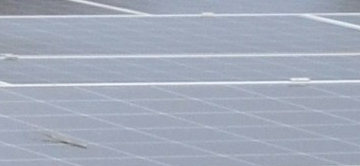On April 28, 2020, Tesla applied to become an electricity supplier in the UK. This initiative does not make Tesla a major player in the electricity market, but, given the dynamism of its CEO, it is only a first step towards a development strategy based on its mastery of battery technology.
Green electrons in a box
To combat global warming, we must leave the carbon-based energy sources that meet our domestic, industrial and transport needs underground. The alternative technologies that are favored by public opinion, and therefore by political decision-makers, are green energies, wind and solar energy, whose production costs have fallen sharply but which have the major disadvantage of intermittency. Since homo industrialis wants lamps to light up when they are needed and not when nature consents, the new frontier of the industry is storage. It should be possible to store, at low cost, the surplus electricity produced by the sun's too hot rays and the unnecessarily furious winds to be retrieved at night and in good weather. But so this visions is still an elusive dream. Electricians know how to transform electrical energy into another form of energy, (potential in pumping stations, chemical in batteries, kinetics with flywheels) and then retransform it into electrical energy at the moment of use. The equipment needed for this double conversion is expensive, and the double conversion is accompanied by a significant loss of energy. At present, water storage by pumping remains the most efficient solution. But locations and volumes are limited by geographical conditions. The future therefore lies in batteries, upstream integrated into the networks, downstream at the place of consumption and under the hood of vehicles. Electricians are racing to develop batteries that are small and light enough, capable of storing a lot of energy quickly and meeting large power demands for a long time, and, while we are at it, at a modest cost.
English license
In November 2017, in its response to a consultation launched by the UK energy regulator (Ofgem) on the role of electricity distributors in the competitive deployment of storage facilities, Tesla stressed that storage is neither generation nor consumption but a substitute for costly grid reinforcement. Indeed, storage is neither a creator nor a destroyer of energy (apart from losses due to any conversion system). It only makes possible the transfer of energy from one date to another, just as a cable transfers it from one place to another. However, in the absence of specific regulations on storage, Tesla's application to the same Ofgem in April concerned a production license. Given Tesla's insistence in its 2017 response cited above that the provision of ancillary services, including real-time network balancing, should be subject to competition law, it is very likely that its objective is to use its storage expertise to gain a foothold in the electricity industry at the distribution network level.
Tesla Energy
Tesla is best known for its electric vehicles (Model S, Model 3). But the company also has an energy division whose main activities are solar panels, solar tiles, and stationary batteries Powerwall (for the home) and Powerpack (for communities and professional sites). And in parallel with the development of electric vehicles, Tesla continues to roll out its network of fast charging stations.
In the field of electricity distribution networks, Tesla has invested in Australia in two phases (2017 then 2019) in a storage space of 185 MWh and 150 MW of discharge power to compensate for the production contingencies of the 99 wind turbines (315 MW capacity) at the Hornsdale site owned by Neoen. Two-thirds of the discharge capacity is reserved by contract with the government to provide system services (maintaining a stable frequency while generation units take over). The other portion is used to arbitrate electricity prices. Given the changing wind conditions and high temperatures in the region, this activity has proved very profitable for Neoen, since during the heat wave in January 2018, the MWh sold for up to 14,000 Australian dollars, or 8,400 euros.
In order to trigger the discharge of the batteries to stabilize the grid, the control electronics only need technical information on the status of the grid. On the other hand, in order to take full advantage of the potential gains from arbitrage, information on energy prices and software acting as a trader is required. To this end, Tesla has placed the Hornsdale batteries under the control of the Autobidder platform.
Electronic Trader
According to Tesla, Autobidder is an artificial intelligence-based software application that allows you to anticipate prices, peak loads and volumes produced and make a profit, or to optimize the network by using the electricity supply from private households, for example. This platform would make it possible to earn money through energy trading while respecting the commercial objectives and risk preferences of the owners and/or operators of storage and distributed supply facilities. The tool is presented by Tesla as a combination of deep learning and optimization algorithms.
It is difficult to assess the true financial performance of this platform in the fog of the usual fuzzy commercial announcements that the company is accustomed to. But the Australian performance has been convincing enough for the company to seek entry into the UK market. More than lithium batteries, a technology already well-mastered by many companies, the platform for trading and real-time control of the charge and discharge phases is the technological breakthrough to watch for in the coming decade.
*
* *
Last year, Elon Musk said Tesla's Energy business is set to grow faster than its Automotive business. But to make money in a sector where a commodity is traded, you don't want to go too far downstream. Consumers may be willing to pay dearly for a recognizable vehicle on the road, not for photovoltaic panels on the roof or a battery in the cellar out of sight of envious neighbors. Rather, we can expect an expansion of energy business at the grid level in the continuation of the Australian experience: installing batteries at strategic grid nodes to provide system services and taking advantage of the opportunity to use some of the power in a lucrative energy trading business. But profitability requires buying at sufficiently low prices and selling at very high prices, which implies very contrasted supplies of intermittent energy according to dates and states of nature. It can therefore be anticipated that Tesla will not be alone in the race to get to the right grid nodes. By organizing auctions for the grid storage market, interested governments should be able to derive some benefit from competition between potential operators.





